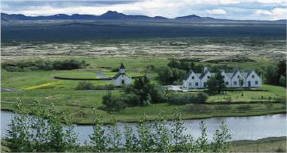|
Facts
About Iceland
Land
Iceland is an island of almost 40,000 square miles, equal to that of
Ohio. Iceland's highest peak, Hvannadalshnukur, is 6,500 ft. Iceland has
the largest glaciers in Europe - in fact, 11% of the country is covered
by glaciers. The coastline is dotted with more than one hundred fjords -
and green, fertile valleys extend from them. Iceland also has more than
10,000 waterfalls and countless hot springs. |
 |
|
Energy
Situated on the Mid-Atlantic Ridge, Iceland is a hot spot of geothermal
activity. Thirty post-glacial volcanoes have erupted in the past two
centuries, and natural hot water supplies much of the population with
cheap, pollution-free heating. Rivers, too, are harnessed to provide
inexpensive hydroelectric power. The electrical current is 220 volts, 50
Hz.
Language
The Icelanders still speak the language of the Vikings (Old Norse). When
new words are needed, they simply coin words that are combinations or
modifications of old words. Iceland is alone in upholding another Norse
tradition: the custom of using patronyms rather than surnames. If, for
example, Einar has a son named "Petur", the son's name is Petur
Einarsson (Peter Einar's Son). If Einar has a daughter whom he names "Margret",
she becomes Margret Einarsdottir (Margaret Einar's Daughter). Members of
the same family can therefore have different "last names", which often
causes confusion to foreigners. If you are looking for someone in the
phone directory, you look them up by their first name.
People
Of a population numbering just over 288,000, more than half lives in the
Greater Reykjavik Area. The native language is Icelandic but most
Icelanders speak fluent English.
Time
In spite of its mid-Atlantic location, Iceland is on Greenwich Mean Time
all year round.
History
The first permanent settler of Iceland was Ingolfur Arnarson, a
Norwegian Viking who in 874 AD made his home where Reykjavik now stands.
In 930 AD, the Viking settlers of Iceland founded one of the world's
first republican governments. They established a constitution based on
individual freedom, land ownership, and sophisticated inheritance laws.
In the year 1000, Icelandic-born Leifur Eiriksson (Leif Eriksson,
sometimes called "Leif the Lucky") became the first European to set foot
in North America. On another Viking expedition a couple of years later,
Icelander Gudrid Thorbjarnardottir had a son, Snorri, who became the
first child of European descent to be born in America. The Old
Commonwealth Age, described in the classic Icelandic Sagas, lasted until
1262, when Iceland lost its independence. In 1918 it regained
independence and in 1944 the present republic was founded. The country
is governed by the Althing (Parliament), whose 63 members are elected
every four years. Elections every four years are also held for the
presidency; President Olafur Ragnar Grimsson was elected in June 2000
for the second time.
Economy
The economy is heavily dependent upon fisheries, which are the nation's
greatest resource. 72% of all exports are made up of seafood products.
Yet only a small proportion of the workforce is active in this sector
(4.4% in fishing and 5.6% in fish processing). About 66% of the
workforce is employed in services. Icelanders enjoy one of the highest
standards of living in the world.
Health
Life expectancy, at 80 years for women and 74 for men, is one of the
highest in the world, and a comprehensive state health-care system aims
to keep it that way.
Church
The National Church of Iceland, to which 97 percent of the population
belongs, is Evangelical Lutheran. In addition to the many Lutheran
churches in Reykjavik, there is a Roman Catholic Cathedral at Landakot,
with regular Sunday Mass.
|

